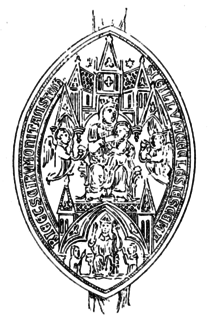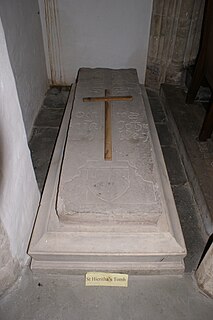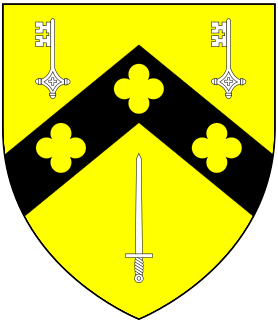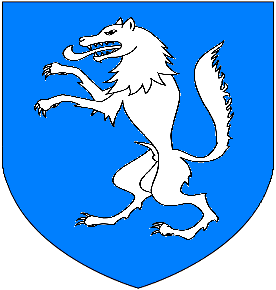Related Research Articles

Childe's Tomb is a granite cross on Dartmoor, Devon, England. Although not in its original form, it is more elaborate than most of the crosses on Dartmoor, being raised upon a constructed base, and it is known that a kistvaen is underneath.

Buckfast Abbey forms part of an active Benedictine monastery at Buckfast, near Buckfastleigh, Devon, England. Buckfast first became home to an abbey in 1018. The first Benedictine abbey was followed by a Savignac abbey constructed on the site of the current abbey in 1134. The monastery was surrendered for dissolution in 1539, with the monastic buildings stripped and left as ruins, before being finally demolished. The former abbey site was used as a quarry, and later became home to a Gothic mansion house.

Tavistock is an ancient stannary and market town within West Devon, England. It is situated on the River Tavy from which its name derives. At the 2011 census the three electoral wards had a population of 13,028. It traces its recorded history back to at least 961 when Tavistock Abbey, whose ruins lie in the centre of the town, was founded. Its most famous son is Sir Francis Drake.

Abbots Bickington is a village and civil parish in the English county of Devon, located 7.7 miles north-northeast of Holsworthy and near the River Torridge.

Crowland Abbey is a Church of England parish church, formerly part of a Benedictine abbey church, in Crowland in the English county of Lincolnshire. It is a Grade I listed building.

Tavistock Abbey, also known as the Abbey of Saint Mary and Saint Rumon, is a ruined Benedictine abbey in Tavistock, Devon. Nothing remains of the abbey except the refectory, two gateways and a porch. The abbey church, dedicated to Our Lady and St Rumon, was destroyed by Danish raiders in 997 and rebuilt under Lyfing, the second abbot. The church was further rebuilt in 1285 and the greater part of the abbey between 1457 and 1458.

Urith was a Brythonic Christian woman from from the Westcountry of Great Britain who was alleged to have been martyred, possibly in the early 8th century, and subsequently revered as a saint. The name is still common in the English county of Devon. Her feast day is 8 July and her shrine is located in the North Devon village of Chittlehampton. Her name is also known in Latin as Hieritha and occasionally corrupted to Erth.

Werrington is a civil parish and former manor now in Cornwall, England, United Kingdom. Prior to boundary changes it straddled the Tamar and lay within the county of Devon. The portion on the west side was transferred to Cornwall in 1966. It is situated 1 mile (1.6 km) to the west of the Tamar, the traditional boundary between Devon and Cornwall, and 1 mile (1.6 km) north of Launceston.

Walter Branscombe was Bishop of Exeter from 1258 to 1280.
Abbot of Tavistock was the title of the abbot of Tavistock Abbey in Devon, England. The name of the first abbot is unknown, but the abbey was founded between 975 and 980. Unless otherwise specified the details in the following table are from Heads of Religious Houses: England & Wales 940–1216.

Gabriel Donne or Dunne was an English Cistercian monk and was the last Abbot of Buckfast Abbey in Devon, before the Dissolution of the Monasteries.

Highweek, less commonly called Highweek Village, in South Devon, England, is a parish, former manor and village, now a suburb of, and administered by, the town of Newton Abbot, but still retaining its village identity. It is prominent and recognisable due to its high location on a ridge on the north edge of the town. The area is the centre of the modern electoral ward of Bradley. Its population at the 2011 census was 5,043.

The landed gentry and nobility of Devonshire, like the rest of the English and European gentry, bore heraldic arms from the start of the age of heraldry circa 1200–1215. The fashion for the display of heraldry ceased about the end of the Victorian era (1901) by which time most of the ancient arms-bearing families of Devonshire had died out, moved away or parted with their landed estates.

The Manor of Molland was a medieval manor in North Devon, England. It was largely co-terminous with the existing parish of Molland, in which is situated the village of Molland. More accurately it consisted from the earliest times of two separate manors, held from separate overlords, later known as Molland-Bottreaux and Molland-Champson.
Herbert Patrick Reginald Finberg (1900–1974) was an English historian and publisher. After working at several publishing companies and founding his own, he joined the faculty of Leicester University in 1952. He became head of the Department of English Local History, which was recognised as the only centre for postgraduate studies in the subject. He edited the journal Agricultural History Review and three volumes of early Anglo-Saxon charters, Early Charters of Devon and Cornwall (1953), Early Charters of the West Midlands (1961) and Early Charters of Wessex (1964). He also edited Scandinavian England. Collected Papers by F. T. Wainwright. Other works included Tavistock Abbey (1949), The Formation of England (1974) and Manual of Catholic Prayer (1962).

Lyneham in the parish of Yealmpton in Devon, is an historic estate. The surviving grand mansion house known as Lyneham House is a grade I listed building. It was built c.1699-1703 by Sir Courtenay Croker, MP for Plympton Morice in 1699. A drawing of Lyneham House dated 1716 by Edmund Prideaux (1693–1745) of Prideaux Place, Padstow, Cornwall, survives at Prideaux Place. It shows formal gardens in front with flanking pavilions and an orangery.

Townstal is an historic manor and parish on elevated ground now forming part of the western suburbs of the town of Dartmouth in Devon.

Milton Abbot is a village, parish, and former manor in Devon, 6 miles (9.7 km) north-west of Tavistock, Devon, and 6 miles (9.7 km) south-east of Launceston, Cornwall.
SaintRumon of Tavistock is a saint venerated in the traditions of the Catholic, Anglican Communion, and Western Orthodox churches.

St Eustachius' Church, Tavistock is a Grade II* listed parish church in the Church of England Diocese of Exeter in Tavistock, Devon.
References
Notes
- ↑ Pole p. 41.
- ↑ Hoskins, W. G.; Finberg, H. P. R. (1952). "The Tragi-Comedy of Abbot Bonus". Devonshire Studies. London: Jonathan Cape.
- 1 2 Finberg p. 277.
- 1 2 3 4 Oliver p. 91.
- ↑ Alexander, J. J. (1937). "Tavistock in the Fifteenth Century". Report & Transactions of the Devonshire Association. 69: 247–285.
- ↑ Finberg p.180.
- ↑ Finberg p. 92, 233.
- ↑ Hall, John G. (December 1931 – January 1932). "Notes on Denbury". Devon & Exeter Gazette.
- ↑ Finberg p. 226.
- ↑ Robert Brentano,Two Churches: England and Italy in the Thirteenth Century, With an Additional Essay by the Author. (University of California Press, 1988) p 246.
- ↑ Church of St Eustachius at Historic England.org.uk.
Bibliography
- Finberg, H. P. R. (2014) [1951]. Tavistock Abbey: A Study in the Social and Economic History of Devon. Cambridge: Cambridge UP. ISBN 9781107453715.
- Oliver, George (1846). "Abbey of Tavistock, in the deanery of Tavistock". Monasticon Dioecesis Exoniensis, Being a Collection of Records and Instruments. Hannaford. pp. 89–112.
- Pole, Sir William (1791). Collections Towards a Description of the County of Devon. J. Nichols.